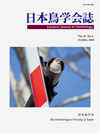Volume 69, Issue 2
Displaying 1-8 of 8 articles from this issue
- |<
- <
- 1
- >
- >|
PREFACE
-
Article type: PREFACE
2020 Volume 69 Issue 2 Pages 195
Published: October 26, 2020
Released on J-STAGE: November 20, 2020
Download PDF (232K)
ARTICLES
-
Article type: ARTICLE
2020 Volume 69 Issue 2 Pages 197-207
Published: October 26, 2020
Released on J-STAGE: November 20, 2020
Download PDF (831K) -
Article type: ARTICLE
2020 Volume 69 Issue 2 Pages 209-221
Published: October 26, 2020
Released on J-STAGE: November 20, 2020
Download PDF (1853K) -
Article type: ARTICLE
2020 Volume 69 Issue 2 Pages 223-234
Published: October 26, 2020
Released on J-STAGE: November 20, 2020
Download PDF (713K)
SHORT NOTE
-
Article type: SHORT NOTE
2020 Volume 69 Issue 2 Pages 235-239
Published: October 26, 2020
Released on J-STAGE: November 20, 2020
Download PDF (684K)
OBSERVATIONAL DATA
-
Article type: OBSERVATIONAL DATA
2020 Volume 69 Issue 2 Pages 241-244
Published: October 26, 2020
Released on J-STAGE: November 20, 2020
Download PDF (496K) -
Article type: OBSERVATIONAL DATA
2020 Volume 69 Issue 2 Pages 245-248
Published: October 26, 2020
Released on J-STAGE: November 20, 2020
Download PDF (799K)
OTHER ARTICLES
-
Article type: OTHER ARTICLE
2020 Volume 69 Issue 2 Pages 249-253
Published: October 26, 2020
Released on J-STAGE: November 20, 2020
Download PDF (524K)
- |<
- <
- 1
- >
- >|
